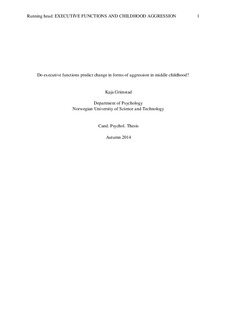| dc.description.abstract | This study investigated concurrent and 2-year longitudinal relations between three executive functions (inhibition, working memory, and shifting) and forms of aggression in children. The Instrument of Proactive and Reactive Aggression (IRPA) was considered for applicability for measuring forms of aggression in middle childhood. The mean age of the sample (n = 844) was 6.7 years at first assessment and 8.8 years at the final assessment. Neuropsychological test scores of executive functions and teacher report of aggression were obtained at both time points. The IRPA was examined through exploratory (EFA) and confirmatory factor analysis (CFA), growth of forms of aggression were regressed on executive functions. Unlike in the original study (Polman, de Castro, Thomaes, & van Aken, 2009) CFA was not able to distinguish physical, verbal and covert forms, but a significant 2-factor solution consisting of physical and covert aggression was identified through revision of the instrument. Regression analysis revealed modest significant concurrent associations between the executive component working memory with physical aggression at first assessment, and with physical and covert aggression at the second assessment. Executive functions, however, did not predict change in any form of aggression. | nb_NO |
